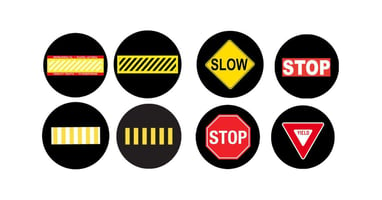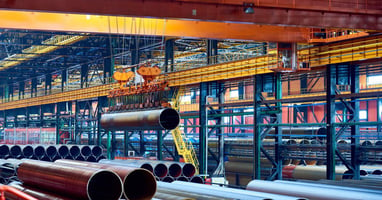When it comes to running a successful warehouse, smooth operations and safety go hand in hand....
A Guide To Creating a Safe Loading Dock Environment

Loading docks are one of the busiest and most dynamic areas in any facility. With so much activity concentrated in a single space, ensuring efficiency while prioritizing safety can be challenging. However, with this guide to creating a safe loading dock environment, you can build a workspace that’s both productive and secure.
We’ll explore essential strategies and tools that make a measurable difference in loading dock safety. From proper design and the use of advanced equipment to effective training and protocols, this knowledge will help you reduce risks and develop safer, more efficient operations.
Why Safety Matters for Loading Docks
Loading docks are always busy transferring goods between vehicles and facilities. The combination of heavy machinery, moving vehicles, and manual labor increases the potential for accidents and injuries. Managers must know how to protect workers from harm while preventing costly damage to equipment and inventory.
Beyond the immediate physical risks, a commitment to loading dock safety has broader implications for an organization. A safe workplace fosters greater employee confidence and morale, leading to higher productivity and retention rates. By integrating robust safety measures, businesses can create a culture of responsibility and care that benefits both employees and operations.
Common Loading Dock Hazards
Loading docks are home to several hazards that can put employees and operations at risk. Being aware of these risks is the first step toward addressing them effectively.
Here are some of the most common dangers found in loading dock environments:
- Slip and trip hazards: Wet or uneven surfaces can cause workers to lose their footing.
- Vehicle collisions: Trucks, forklifts, and other machinery operating in confined spaces increase the likelihood of accidents.
- Falls: Workers may fall from unprotected edges or dock plates, leading to significant injuries.
- Improper handling of heavy loads: Incorrect techniques or faulty equipment can result in dropped loads or physical strain.
- Environmental hazards: Poorly lit spaces, extreme weather conditions, or inadequate ventilation can compound existing safety risks.
Addressing these hazards requires both strategic planning and the deployment of specific warehouse safety products designed to mitigate these dangers.
Designing a Safe Loading Dock
The foundation of a safe loading dock starts with thoughtful design. Whether you're building a new dock or updating an existing one, prioritizing safety in the layout can have long-lasting benefits.
Start by ensuring ample space for maneuvering vehicles and equipment. Congested docks increase the risk of collisions and make loading and unloading activities cumbersome. Adding clearly marked traffic zones and pedestrian pathways can significantly reduce confusion and accidents.
Additionally, dock plates should be stable and rated for the weights they’ll support. Install proper edge protection, such as barriers or guardrails, to prevent accidental falls. Ensure bright and consistent lighting, both outdoors and indoors, to minimize visibility issues during all hours of operation.

Implementing Safety Equipment and Tools
By equipping your facility with the right tools, you can significantly reduce the risk of injuries and accidents while ensuring smooth daily operations. Below are some of the key safety equipment and tools to consider for your loading dock:
- Wheel chocks: Prevent vehicles from moving unexpectedly during loading or unloading
- Dock levelers: Ensure a smooth transition between the dock and the truck bed
- Safety barriers and bollards: Protect workers and equipment from potential collisions
- Trailer restraints: Secure trailers in place to avoid accidental movement
- Safety mirrors and cameras: Enhance visibility and reduce blind spots across the dock area
Implementing newer technologies is always a wise decision to minimize human error and increase safety.
Training and Educating Employees
Even the best safety tools are ineffective if workers lack the knowledge to use them correctly. Training employees is a crucial aspect of any robust safety program.
Begin with comprehensive onboarding covering the fundamentals of safe operating procedures in the loading dock area. Then, move on to specialized training sessions that address specific risks tied to equipment use or hazardous materials.
Ensure workers can identify potential hazards and respond effectively. Practical, hands-on demonstrations are often more impactful than theoretical lessons. To maintain a strong safety culture, offer periodic refresher courses, and encourage open dialogue around concerns or suggestions employees may have.
When employees feel empowered and informed, they’re more likely to adopt safety measures as part of their daily routines.
Establishing Clear Safety Protocols
Clear safety protocols serve as a road map, guiding workers on the correct practices to follow. Without well-documented and communicated guidelines, even the most safety-conscious employees can inadvertently make mistakes. Here’s how to establish effective protocols:
- Standard operating procedures (SOPs): Create step-by-step instructions for everyday tasks such as lifting, stacking, and unloading goods.
- Signage: Use visible signs to outline key safety rules or risks, such as “Caution: Slippery Surface” or “Pedestrian Zone.”
- Emergency procedures: Develop clear, easy-to-follow instructions on what employees should do during incidents involving equipment malfunctions or fires.
- Communication systems: Encourage workers to report unsafe conditions without fear of retribution.
Make it a priority to review and update these protocols regularly as operations evolve or new risks emerge.

Conducting Regular Inspections and Maintenance
Regular inspections and maintenance are essential for ensuring a safer loading dock environment. By routinely checking equipment, structures, and safety mechanisms, potential hazards can be identified and addressed before they lead to accidents. This proactive approach minimizes risks by ensuring that all loading dock operations run smoothly and efficiently.
Emergency Preparedness and Response
Incidents can happen even when you have the best safety measures in place. Being prepared for emergencies ensures that the team knows how to respond quickly, minimizing damage and harm.
Equip your loading dock with fire extinguishers, spill control kits, and first aid supplies in easily accessible locations. Conduct evacuation drills and simulations to familiarize employees with emergency exits and protocols.
Additionally, maintain relationships with local emergency response teams for external support during larger incidents. The combination of internal training and external collaboration will solidify your emergency preparedness strategy.
Staying Compliant With Regulations
Meeting regulatory requirements for loading dock safety is a legal obligation and an ethical responsibility. Noncompliance can lead to injuries, costly fines, or even shut down your operations.
To ensure you remain compliant with safety standards, make sure to familiarize yourself with local workplace safety regulations, such as OSHA. Perform periodic safety audits with third-party experts to identify vulnerabilities in your operations, and stay informed about evolving regulations and industry best practices related to loading dock safety.
Keep records of training, inspections, and incident reports—you’ll need these for compliance and continuous improvement.
Creating a safe loading dock environment is essential for protecting your employees, streamlining operations, and minimizing risks. By addressing potential hazards, investing in proper equipment, and fostering a safety-focused culture, you can significantly reduce accidents and improve your team’s overall efficiency.




